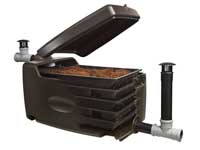Installing the Greywater Filter light
Place the filter on a firm and even surface that is not susceptible to frost, such as, for example, a bed of gravel or crushed stone or a cast concrete slab. The filter must be in a horizontal position both lengthwise and laterally to allow the wastewater flow smoothly over the entire cleaning area of the filter material.
Locating out of doors
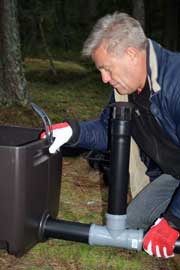
The Biolan Greywater Filter light shall be installed above ground or buried partly in the soil. Place the filter in a location where water will not gather, even when there is flooding. The purifier can be installed out of doors without covering. The unit is non-insulated. For winter use, the unit must be located in a space where the temperature stays above zero.
Location inside a residential building
If the filter is to be installed indoors or in close proximity to a residential building (for example, under the terrace), it must be taken into account during the planning that this space needs to be provided with its own entrance for maintenance. This space must also have a floor well or an earthen floor of sufficient area to enable possible malfunctions to be dealt with satisfactorily.
Air circulation
The operation of the filter is based on the activity of the micro-organisms. The micro-organisms need oxygen to survive. This means that the air exchange in the filter must be looked after. To ensure sufficient exchange, the module delivery includes two T-branches for building up the air exchange system. A prerequisite for efficient natural ventilation is the height difference between the air inlet and outlet (from lower to higher), and possible temperature difference (from colder to warmer).
The replacement air for the purifier is routed from the end of the discharge pipe or via the air pipe that rises above the ground surface from the discharge pipe. The outlet air from the purifier located out of doors shall be routed as extract ventilation to the roof or via an air pipe in the incoming sewer to the yard. Outlet air from a purifier located indoors or in the immediate vicinity of a residential building shall be routed as extract ventilation to the roof of the building.
Conducting wastewater to the filter
The wastewater is conducted directly to the filter using either gravity flow drainage or a pump well. While installing gravity flow sewers, a sufficient gradient (of at least 1-1,5 %) needs to be provided to allow the wastewater to flow without obstruction from the sewer outlet of the house all the way to the discharge point. No septic tank required.
The module is fitted with inlet and outlet connectors for a 75 mm sewage pipe. The inlet connector is located at the upper edge, and the outlet connector at the lower edge of the module. It is possible to connect two modules in series or in parallel.
Series connection
The sewage pipe coming out of the building is connected to the first module. The outlet pipe of the module is connected to the inlet connector of the other module. From the second module, water is routed to the discharge point in the usual manner.
Parallel connection
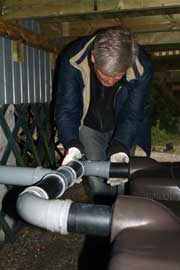 Wastewater is divided into two flows by means of a branch sleeve. To ensure even distribution, it is recommended to provide the inlet pipe with a straight part 80-cm long before the branch sleeve to reduce the turbulence of the incoming water flow.
Wastewater is divided into two flows by means of a branch sleeve. To ensure even distribution, it is recommended to provide the inlet pipe with a straight part 80-cm long before the branch sleeve to reduce the turbulence of the incoming water flow.
Connecting together four modules
Wastewater is divided into two modules that are connected in parallel, after which two more units have been installed in series.
Making use of existing septic tanks
If you wish to make use of existing septic tanks, these need to be in good condition and hermetically sealed.
Pumping wastewater to the filter
The operation of the pump must be sequenced using a timer so that during one sequence the pump brings at maximum 20 litres of wastewater to the filter. If the wastewater system consists of only one module, the recommended pumping rate is10 litres. The Biolan Timer, the Submersible Pump and the Pump Well are available as options.
Discharge point for wastewater
Conduct the treated wastewater to a suitable discharge point, for example a stone pocket, an infiltration pit or an open ditch. When planning, observe that the discharge of wastewater shall be unobstructed even when the surface water or groundwater level is high. If you conduct the water to an open ditch, provide the end of the pipe with a flap or a net to prevent rodents or other small animals from gaining access.
Putting the filter material in place
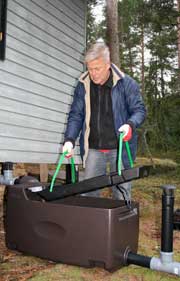 The filter material is packed in a bag inside the unit, and is distributed from the bag into the boxes. Rip the material loose and spread it evenly across the box by tapping it gently. Depending on the packing method applied, there may be excess filter material in the bag. The amount of filter material in the box is sufficient when its surface lies about 2 cm below the edge of the box. Finally, draw the filter material about 5 cm to the rear from the V-openings in the discharge end of the box.The filter boxes are stacked firmly one on top of the other, inside the filter, each one pointing in the opposite direction to the previous one:
The filter material is packed in a bag inside the unit, and is distributed from the bag into the boxes. Rip the material loose and spread it evenly across the box by tapping it gently. Depending on the packing method applied, there may be excess filter material in the bag. The amount of filter material in the box is sufficient when its surface lies about 2 cm below the edge of the box. Finally, draw the filter material about 5 cm to the rear from the V-openings in the discharge end of the box.The filter boxes are stacked firmly one on top of the other, inside the filter, each one pointing in the opposite direction to the previous one:
- discharge openings of the lowermost box (V-openings) on the discharge sewer's side
- discharge openings of the second lowest box on the inlet sewer's side etc.
In this case, water circulates through all of the boxes before being discharged.
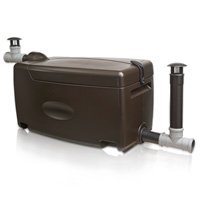





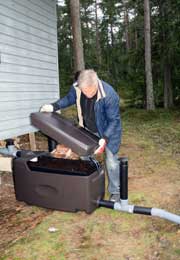 The unit must be used and maintained in accordance with the instructions, and its operation must be monitored regularly. When maintaining the wastewater system, maintenance of the pump well and the sedimentation tanks, if any, also needs to be taken into account.
The unit must be used and maintained in accordance with the instructions, and its operation must be monitored regularly. When maintaining the wastewater system, maintenance of the pump well and the sedimentation tanks, if any, also needs to be taken into account.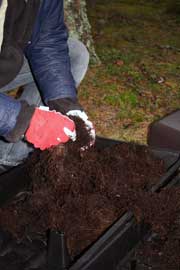 Change the filter material in all of the boxes at the same time.
Change the filter material in all of the boxes at the same time.
 Wastewater is divided into two flows by means of a branch sleeve. To ensure even distribution, it is recommended to provide the inlet pipe with a straight part 80-cm long before the branch sleeve to reduce the turbulence of the incoming water flow.
Wastewater is divided into two flows by means of a branch sleeve. To ensure even distribution, it is recommended to provide the inlet pipe with a straight part 80-cm long before the branch sleeve to reduce the turbulence of the incoming water flow. The filter material is packed in a bag inside the unit, and is distributed from the bag into the boxes. Rip the material loose and spread it evenly across the box by tapping it gently. Depending on the packing method applied, there may be excess filter material in the bag. The amount of filter material in the box is sufficient when its surface lies about 2 cm below the edge of the box. Finally, draw the filter material about 5 cm to the rear from the V-openings in the discharge end of the box.The filter boxes are stacked firmly one on top of the other, inside the filter, each one pointing in the opposite direction to the previous one:
The filter material is packed in a bag inside the unit, and is distributed from the bag into the boxes. Rip the material loose and spread it evenly across the box by tapping it gently. Depending on the packing method applied, there may be excess filter material in the bag. The amount of filter material in the box is sufficient when its surface lies about 2 cm below the edge of the box. Finally, draw the filter material about 5 cm to the rear from the V-openings in the discharge end of the box.The filter boxes are stacked firmly one on top of the other, inside the filter, each one pointing in the opposite direction to the previous one: